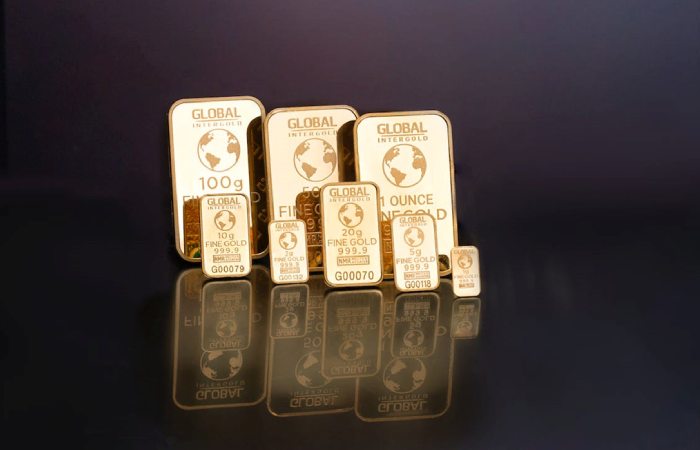With diversification, investors can lessen the impact of the market’s ups and downs on their returns. Gold is commonly advised as a means of portfolio diversification due to its historical performance during stock market crises. Gold is frequently referred to be “insurance” for investors because of its role in protecting wealth during periods of political unpredictability, high inflation, as well as market volatility.
Table of Contents
What Factors into the Cost of Gold?

If you want to buy or sell 1 ounce of gold right now, the price you need to know is the “spot” price. It fluctuates constantly based on what is determined in worldwide metal exchanges. The media often reports the spot price, but that’s just a rough estimate of what a regular investor would have to spend.
Manufacturers and suppliers of bullion demand a premium above the current price to cover their overhead, fabrication, storage, transportation, and other costs. The markup is calculated by subtracting the spot price from the retail price. Do you Really Need Bullion in Tangible form?

Coins and bars are the two main forms of physical bullion. It’s crucial to know the origins of these goods and the vendors peddling them. Investors can rest easy knowing they’re getting their money’s worth by doing their due diligence and researching the company’s background and reputation.
Having physical bullion in one’s possession is crucial to certain people. This is so because there is no longer any “counterparty risk” involved. The risk that a contracting party will not be able to fulfill its obligations to another party is known as counterparty risk.
Moreover, you should think about where you’ll keep your stuff. A secure home safe is usually a prerequisite for avoiding loss or theft. Investors in physical bullion also have the option of utilizing the secure storage facilities of a bank or a dedicated depository service.
Investors can Acquire Gold in other ways

The gold price could be accessed indirectly through the purchase of shares in a gold mining company. Not only is it convenient to make trades via an internet platform, but doing so eliminates the need for physical storage of stock. An increase in the price of gold should, in theory at least, increase the value of shares in a gold producer and any dividends it may pay out.
However, not every gold mining firm is created equal. To maximize the likelihood of a positive return on investment. Future profits may be affect by range factors, the competence of its management, the firm’s ESG strategy, or even political factors.
The use of ETPs, or exchange-traded products, has skyrocketed in recent years. The goal of gold ETPs is to replicate the performance of a specific underlying index. Investors who do not want to physically keep the metal themselves have another choice, and exchanging them is as simple as buying and selling shares.
Much like when investing in stocks, it is the responsibility of the buyer to do their due diligence before making a purchase. Who is the product issuer? is a crucial question to ask. Who are the parties involved? Who owns the gold that this product is backed by legally? How do you convert your investment into gold bullion?
It’s similar to how a savings account works, except for gold. Gold is purchased using deposits, and the total value of the assets rises or falls according to the fluctuating current price of gold. Furthermore, it’s vital for investors to know whether the supplier possesses enough underlying metal to cover the value of all deposits, as several features and benefits are offered. Be sure to look into Bonds Online, among other options to find out more!
The Difference Between “Allocated” and “Unallocated” Gold
The gold used to back these goods can be purchased in either a “allocated” or “unallocated” manner. If you’re an investor, you should go with allocated because it’s the most secure option. Gold cast bars of one kilo or four hundred ounces are the standard form in which this asset is held.
Each bar is marked with its own unique identity (usually a serial number). Weight, percentage of purity, and the name as well as hallmark of the refiner who produced it. The investor has full legal title to the gold in the vault where it has been allocated.
Unallocated gold includes gold in various states, such as gold in a vault. Gold in the form of doré (partially refined) from gold miners. Gold in the form of scrap from gold jewelry aggregators, and gold in the process of being minted as well as cast into specific coins or bars. All unallocated gold may not be of investment quality.
Exactly how Simple is it to Trade Gold for Cash?
Gold’s ability to be quickly and easily changed into cash. Without lowering its market value is what is meant by the term “liquidity.” Gold is among the most liquid asset classes in the world, with a daily turnover of more than USD 150 billion. Therefore, if you want to sell your gold, you can find many purchasers at a fair price.
Yet, there will be an exit charge to pay just as with any other investment. The premium is the difference between the ‘bid’ price and the ‘ask’ price. Try to find businesses that maintain the narrowest possible “spread” in this regard.
Should Investors have a Certain Amount of Gold on Hand?
The question of how much gold is necessary to reduce risk and boost returns is a natural. One for investors considering adding the precious metal to their portfolios. Numerous scholarly works have attempted to answer the topic of what fraction of one’s assets should be in gold.
The World Gold Council reports that a 6% to 10%. Allocation to gold in the typical American investment portfolio has led to a noticeable increase in performance and long-term returns. Although everyone’s financial situation and goals are different, understanding these factors can help guide your choices.

